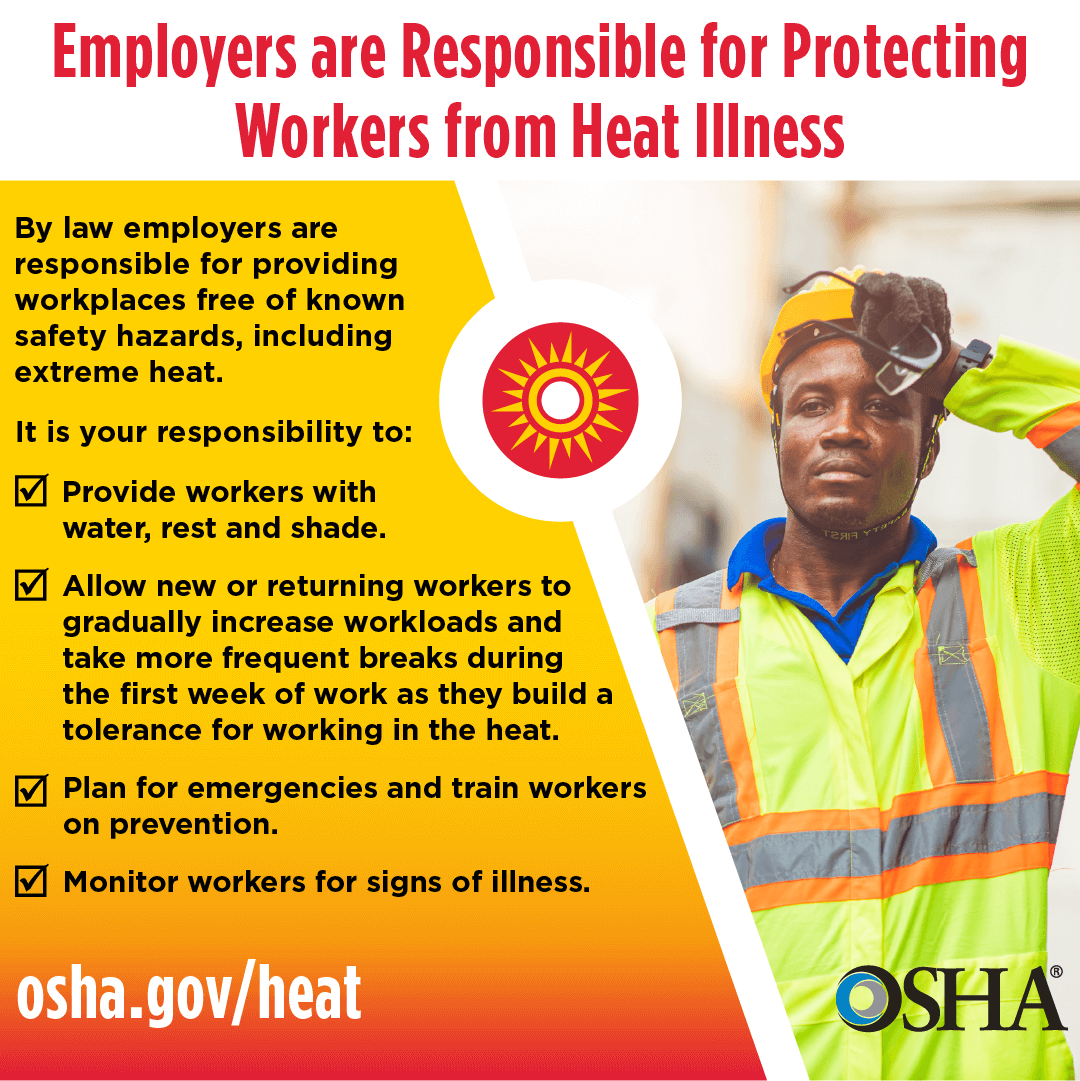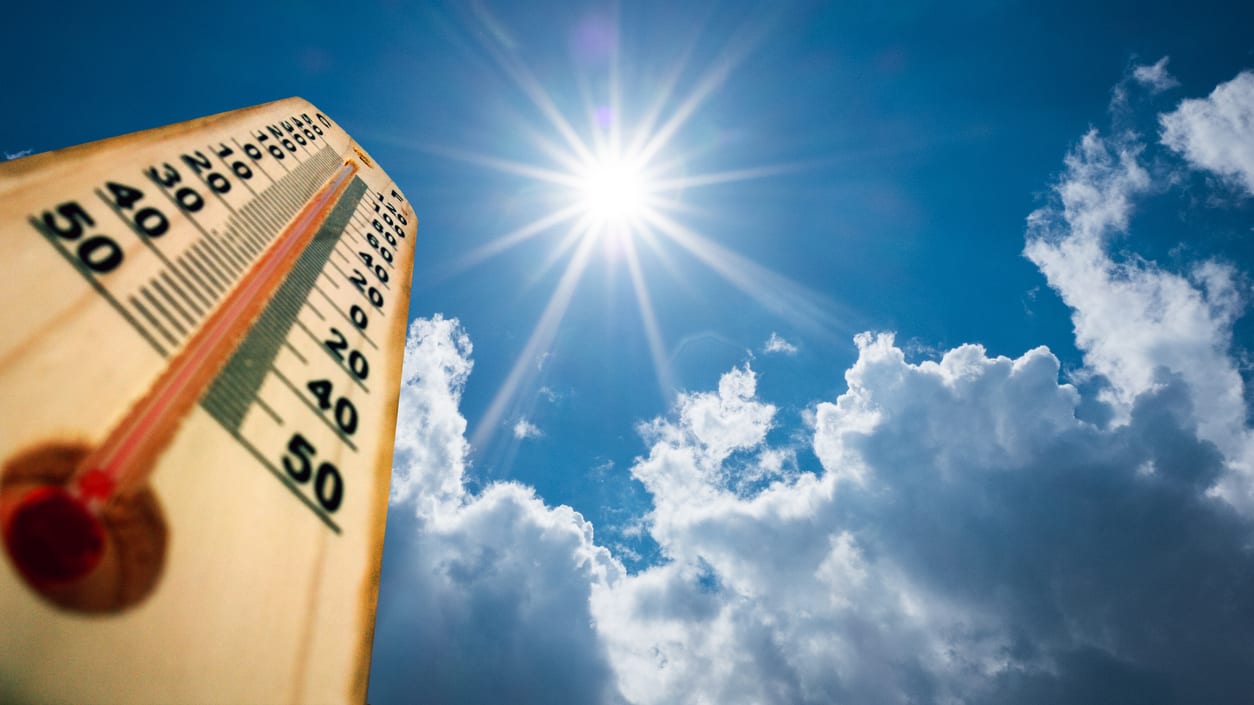A scorching heat wave is rolling around the world, with record-setting temperatures in Asia, Europe and North America. Britain hit a high of 104.5 degrees Fahrenheit on July 19 and in the U.S., nearly a third of the states face excessive heat, with heat warnings and advisories for parts or all of 28 states.
Employers have a duty to make sure workers avoid heat illnesses. Outdoor workers need water, rest and shade to make it to the end of their workday safely. Indoor workers, such as those in warehouses, boiler rooms, kitchens and laundries, can be affected by heat stress, too.
Water, rest and shade can help prevent many heat illnesses, including heat exhaustion and heat stroke. Hard work in hot weather can raise body temperatures higher than the body can cool itself by sweating. Heat illness might manifest initially as heat rash or heat cramps but can become heat exhaustion and then heat stroke quickly.

Different people get used to the heat at different times: Most young, healthy people who increase their exposure to the hot weather gradually should be acclimatized fully within 14 days. People who are not used to strenuous activity and who exercise sporadically might take longer to adapt.
Signs and Symptoms
Be on the lookout for these symptoms of heat illness, according to the National Oceanic and Atmospheric Administration (NOAA):
Sunburn: Redness and pain. In severe cases, swelling of skin, blisters, fever and headaches.
First Aid: Ointments for mild cases if blisters appear and do not break. If breaking occurs, apply dry sterile dressing.Heat cramps: Painful spasms usually in the muscles of legs and abdomen with heavy sweating.
First Aid: Firm pressure on cramping muscles or gentle massage to relieve spasm. Give sips of water. If nausea occurs, discontinue water.Heat exhaustion: Heavy sweating; weakness; cold, pale, clammy skin; thready pulse; fainting and vomiting but might have normal temperature.
First Aid: Get victim out of sun. Once inside, the person should lay down and loosen his or her clothing. Apply cool, wet cloths. Fan or move victim to air conditioned room. Offer sips of water. If nausea occurs, discontinue water. If vomiting continues, seek immediate medical attention.Heat stroke (or sunstroke): High body temperature (106° F or higher), hot dry skin, rapid and strong pulse, possible unconsciousness. Heat stroke is a severe medical emergency. Summon emergency medical assistance or get the victim to a hospital immediately.
First Aid: Delay can be fatal. While waiting for emergency assistance, move the victim to a cooler environment and reduce body temperature with cold bath or sponging. Use extreme caution. Remove clothing, use fans and air conditioners. If temperature rises again, repeat process. Do NOT give fluids. Persons on salt restrictive diets should consult a physician before increasing their salt intake.
Follow these tips to prevent heat illness:
Drink water often, take breaks and limit time in the heat.
Build up to heavy work gradually in hot conditions. Help workers become acclimated, especially workers who are new to working outdoors in the heat or have been away from work for a week or more. Gradually increase workloads and allow more frequent breaks during the first week of work.
Slow down. Reduce, eliminate or reschedule strenuous activities until the coolest time of the day.
Dress for summer. Wear lightweight, light-colored clothing to reflect heat and sunlight.
Put less fuel on inner fires. Foods such as meat and other proteins that increase metabolic heat production also increase water loss.
Drink plenty of water and nonalcoholic and decaffeinated fluids. Your body needs water to keep cool. Drink plenty of fluids even if you don’t feel thirsty. Persons who have epilepsy or heart, kidney or liver disease, who are on fluid restrictive diets or who have a problem with fluid retention should consult a physician before increasing their consumption of fluids. Do not drink alcoholic beverages; limit caffeinated beverages.
Pay Attention to the Heat Index
The heat index can make all the difference in how safe it is to work outside on a given day, according to NOAA. The National Weather Service, a division of NOAA, uses the heat index to determine whether to issue watches, warnings and advisories for excessive heat.
The Occupational Safety and Health Administration (OSHA) issued a free app for Android-based mobile devices and iPhone devices that enables workers and supervisors to monitor the heat index at their worksites. The app displays a risk level for workers based on the heat index as well as reminders about protective measures that should be taken at that risk level. English and Spanish versions are available.
Other SHRM resources:
Washington State Employers Face New Rules to Protect Workers from Outdoor Heat Exposure, SHRM Online, June 2022
OSHA Announces Program to Protect Workers from Heat Hazards, SHRM Online, April 2022
Hot Weather Safety, SHRM Express Requests
An organization run by AI is not a futuristic concept. Such technology is already a part of many workplaces and will continue to shape the labor market and HR. Here's how employers and employees can successfully manage generative AI and other AI-powered systems.




